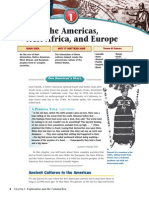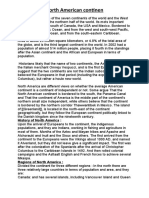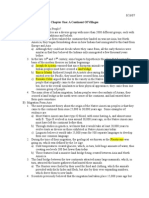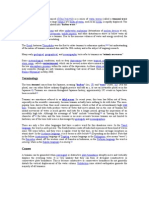0 ratings0% found this document useful (0 votes)
193 viewsA People Living in God 1
A People Living in God 1
Uploaded by
api-166598868Copyright:
© All Rights Reserved
Available Formats
Download as DOCX, PDF, TXT or read online from Scribd
A People Living in God 1
A People Living in God 1
Uploaded by
api-1665988680 ratings0% found this document useful (0 votes)
193 views2 pagesOriginal Title
a people living in god 1
Copyright
© © All Rights Reserved
Available Formats
DOCX, PDF, TXT or read online from Scribd
Share this document
Did you find this document useful?
Is this content inappropriate?
Copyright:
© All Rights Reserved
Available Formats
Download as DOCX, PDF, TXT or read online from Scribd
Download as docx, pdf, or txt
0 ratings0% found this document useful (0 votes)
193 views2 pagesA People Living in God 1
A People Living in God 1
Uploaded by
api-166598868Copyright:
© All Rights Reserved
Available Formats
Download as DOCX, PDF, TXT or read online from Scribd
Download as docx, pdf, or txt
You are on page 1of 2
A People Living in God: Early North American Cultures
Randall H. McGuire Cobblestone Magazine April 1993
There were no Indians in North America when Christopher Columbus landed in
the Bahamas five hundred years ago, but more than ten million people lived in what is
now the United States. Among them were Din, OOdham, Lakota, Qwidicca-atx,
Wampanoag, Ganienghaka, and a host of other nations. They spoke hundreds of
different languages. In most of these languages, the name they called themselves
means the people in English. These people became Indians when Columbus called
them una gente en dios, a people living in God. In Spanish, their name became
Indios, or Indians.
The Indians world was not a new world. According to archaeologists, the first
Indians came to North America more than twenty thousand years before Columbus.
During the last Ice Age, the great glacial ice sheets took up so much water that the
oceans shrank. The Bering Strait, between Siberia and Alaska, dried up. A broad land
bridge connected Asia and North America. Asian hunters followed game over the
bridge into North America. Many modern Indian people do not accept this theory of
migration. They believe that the people were created with the land. The stories they tell
explain who they are, where they came from, what the borders of their world are, and
how they should live as humans. Each nation has its own creation story. The Zuni story
elsewhere in this issue is one example.
Archaeologists call the first people in North America Paleo-Indians. Paleo is a
Greek word meaning early. These early Indians found a colder climate than the one
we know today. Great ice sheets covered much of Canada. The northern United States
had an arctic climate. The deserts of the western United States were lush grasslands
dappled with large lakes. Paleo-Indian hunters used finely made stone projectile points
to hunt large animals such as mammoths (extinct elephants) and bison. By nine
thousand years ago, the climate was becoming warmer. The ice sheets melted, and
the lakes in the West dried up, leaving the modern deserts.
The lives of Indian peoples changed. Archaeologists call this new way of life the
Archaic Phase. Archaic peoples adapted their way of life to the specific environment in
which they lived. People hunted smaller game, such as deer and rabbits. They
gathered wild grass seeds and ground them into flour. They collected shellfish along
the rivers of the eastern United States and along the coasts. They threw the shells in
large piles. In the far western United States and in most of Canada, the Archaic Phase
lasted until the eighteenth century A.D.
In the eastern and southwestern United States, a new way of life, the Formative
Phase, replaced the Archaic. These people lived year-round in one settlement, made
pottery, and grew crops. They built great mounds and stone buildings that still dot the
landscape.
Archaeologists divide the Formative Phase of the East into the Adena, Hopewell,
Late Woodland, and Mississippian periods. Adena people (500-100 B.C.) brought wild
sunflowers, amaranth (pigweed), and squash into their gardens. They bred the wild
plants to produce larger, domestic varieties. They buried their dead in large mounds of
earth. They built one mound in present-day Ohio to look like a snake eating an egg.
During the Hopewell Period, people continued to build mounds, and they began a trade
network that covered most of the eastern United States. This trade network fell apart in
about A.D. 400, which marks the start of the Late Woodland Period.
By 800, people based their agriculture on corn, beans, and squash. These crops
came from Mexico, where Indian people had grown them for thousands of years. The
Late Woodland Period continued in much of the East until the Europeans arrived, but
in the South, it changed into the Mississippian Period (700-1540). Mississippian
societies divided people into nobles, priests, and commoners. The nobles and priests
lived on high, flat mounds in great towns of up to twenty thousand people. The modern
Cherokee, Creek, Choctaw, Seminole, and Chickasaw Indians are the descendants of
the Mississippian people.
Corn arrived in the Southwest before 1000 B.C., and by A.D. 100, three Formative
cultures existed. The Anasazi culture began in the Four Corners region, where the
states of Colorado, Utah, Arizona, and New Mexico meet. The Anasazis built large
apartment buildings called pueblos and made white pottery with black designs. At the
end of the thirteenth century, the Anasazis moved to the Rio Grande, where their
descendants live today.
The Mogollon people lived in the mountains and made brown pottery with red
designs. Around A.D. 1450, they moved north to become the Hopi and Zuni Indians. In
the deserts of southern Arizona, the Hohokam built large canals to water their fields
and made buff pottery with red designs. Their descendants, the Pimas, still farm
among the ruins of their ancestors.
In 1492, most of the Indian people of North America were farmers who lived in villages.
European diseases and war destroyed the Mississippian culture and greatly reduced
the farmers of the Southwest. Today almost two million Indian people live in the United
States. Several hundred Indian nations survive, and more than two hundred native
languages are spoken.
You might also like
- An Introduction To Physical Geography and The Environment PDFDocument841 pagesAn Introduction To Physical Geography and The Environment PDFCrystal100% (12)
- US History CH 1 Ancient Times To 1492Document25 pagesUS History CH 1 Ancient Times To 1492M Imtiaz Shahid92% (12)
- Civilizations of PeruDocument108 pagesCivilizations of Peruleonel larsonNo ratings yet
- NATIVE PEOPLES OF AMERICA Chapter 01Document7 pagesNATIVE PEOPLES OF AMERICA Chapter 01dheerajroykumarroyNo ratings yet
- The First Americans PrehistoryDocument23 pagesThe First Americans Prehistorymblum78100% (1)
- 100 Ihp 2Document11 pages100 Ihp 2xiolyNo ratings yet
- The History of USADocument98 pagesThe History of USAAnonymous An4Lip4zv100% (2)
- 1-1 - Americas West Africa EuropeDocument10 pages1-1 - Americas West Africa Europeapi-262954277No ratings yet
- 1.1 - pg4 - 13 The AmericansDocument10 pages1.1 - pg4 - 13 The AmericansJoe Bradley100% (1)
- Ancient North AmericansDocument3 pagesAncient North AmericanswoundedbatNo ratings yet
- Native Peoples of America, To 1500: Chapter OutlineDocument21 pagesNative Peoples of America, To 1500: Chapter Outlinemocacola15100% (1)
- The Beginnings of AmericaDocument3 pagesThe Beginnings of AmericaAlisha AlishaNo ratings yet
- 1.1. Pre-Columbian History of Native Americans.: An Outline of American History, United States Information Agency, P 7Document6 pages1.1. Pre-Columbian History of Native Americans.: An Outline of American History, United States Information Agency, P 7bella19883757No ratings yet
- Chapter1Document1 pageChapter1echonemisisNo ratings yet
- CH 16 Sec 1 - North American Societies PDFDocument5 pagesCH 16 Sec 1 - North American Societies PDFJ. Nieves100% (1)
- Lesson 1the First AmericansDocument37 pagesLesson 1the First Americansfishertr1No ratings yet
- The 10 Largest Native American Tribes - US History 3rd Grade | Children's American HistoryFrom EverandThe 10 Largest Native American Tribes - US History 3rd Grade | Children's American HistoryNo ratings yet
- U.S. History I Lecture Notes On Exploration and Colonization (CH 1)Document7 pagesU.S. History I Lecture Notes On Exploration and Colonization (CH 1)Juan Carlos OlivasNo ratings yet
- North American Continen: History of North AmericaDocument4 pagesNorth American Continen: History of North AmericaMohamed Yacine SalhiNo ratings yet
- Chapter 1 The First Americans TextDocument25 pagesChapter 1 The First Americans TextJon BentonNo ratings yet
- The Indigenous Peoples and The EuropeansDocument2 pagesThe Indigenous Peoples and The EuropeansPooNo ratings yet
- CH 9 Sec 1 - The Earliest Americans PDFDocument5 pagesCH 9 Sec 1 - The Earliest Americans PDFJ. Nieves100% (1)
- Chapter 1: Overview of The First Americans: Digital History ID 2908Document13 pagesChapter 1: Overview of The First Americans: Digital History ID 2908Joey VNo ratings yet
- Paleo-Indians: Pre-Columbian North AmericaDocument27 pagesPaleo-Indians: Pre-Columbian North AmericaHammad RaoNo ratings yet
- Exploration and Colonization of AmericaDocument26 pagesExploration and Colonization of AmericaUsra RasoolNo ratings yet
- History 53 - A AmericasDocument23 pagesHistory 53 - A AmericasDivinekid082No ratings yet
- The Ancient IncaDocument141 pagesThe Ancient Incamaria100% (1)
- The Anasazi PeopleDocument1 pageThe Anasazi PeopleTaty Cerrato de JorqueraNo ratings yet
- Period 1.0 - America Before Columbus and Motivations For ExplorationDocument82 pagesPeriod 1.0 - America Before Columbus and Motivations For ExplorationWilliam NorthernNo ratings yet
- Upwork Pages 11-25Document16 pagesUpwork Pages 11-25geseratienza30No ratings yet
- A History of Science and Technology Part 2Document2 pagesA History of Science and Technology Part 2lance cunananNo ratings yet
- America - A New World (An Illustrated History of The USA)Document11 pagesAmerica - A New World (An Illustrated History of The USA)Cristina Georgiana Rosu0% (1)
- Earliest AmericansDocument1 pageEarliest AmericansJ.J landaverde WALKS 9ANo ratings yet
- First AmericansDocument9 pagesFirst AmericansyeleninNo ratings yet
- Chapter 2 The First AmericansDocument54 pagesChapter 2 The First Americansahudsonwm100% (1)
- History of American IndianDocument5 pagesHistory of American IndianPhan Minh Thùy NhưNo ratings yet
- Chapter 1 Roots of American People Animated 2013highlight - NotesDocument72 pagesChapter 1 Roots of American People Animated 2013highlight - NotesWilliam DoyleNo ratings yet
- Explore Native American Cultures!: With 25 Great ProjectsFrom EverandExplore Native American Cultures!: With 25 Great ProjectsRating: 3 out of 5 stars3/5 (1)
- Early Native Americans in Our AreaDocument24 pagesEarly Native Americans in Our AreaAdolfo RojanoNo ratings yet
- Passion ProjectDocument6 pagesPassion ProjectalanisoeNo ratings yet
- American Pageant 13 Ch. 1-5 GuideDocument19 pagesAmerican Pageant 13 Ch. 1-5 GuideTautsu100% (2)
- The Americas, West Africa, and EuropeDocument10 pagesThe Americas, West Africa, and Europelabrin.paula2712No ratings yet
- Histiry of Amerians DocumentDocument13 pagesHistiry of Amerians DocumentGuna SekaranNo ratings yet
- AP* U.S. History Review and Study Guide Aligned With American Pageant 15th EditionFrom EverandAP* U.S. History Review and Study Guide Aligned With American Pageant 15th EditionNo ratings yet
- Chapter One: A Continent of VillagesDocument33 pagesChapter One: A Continent of Villagesapi-171412573No ratings yet
- Almanacs 49392Document280 pagesAlmanacs 49392gorgeriderNo ratings yet
- Almanacs 47209Document178 pagesAlmanacs 47209gorgeriderNo ratings yet
- 01 First American First EuropeansDocument4 pages01 First American First EuropeansmrNo ratings yet
- Almanacs 45001Document176 pagesAlmanacs 45001gorgeriderNo ratings yet
- CONTACT: Europeans and AmerindiansDocument199 pagesCONTACT: Europeans and Amerindiansnoo one100% (1)
- AR Week 1Document14 pagesAR Week 1mayan.omseemaNo ratings yet
- Picture ThisDocument10 pagesPicture Thisapi-28395916No ratings yet
- American and Latin-American Indians:: A Brief and Informative Guide-And Much MoreFrom EverandAmerican and Latin-American Indians:: A Brief and Informative Guide-And Much MoreNo ratings yet
- History of The AmericasDocument5 pagesHistory of The Americasdave martinNo ratings yet
- Chapter One: A Continent of Villages I. Settling The ContinentDocument7 pagesChapter One: A Continent of Villages I. Settling The Continentboardon24No ratings yet
- The Great Plains: Students' Names: Lucchesi FlorenciaDocument4 pagesThe Great Plains: Students' Names: Lucchesi FlorenciaMartina CantosNo ratings yet
- 12Document11 pages12ANK SHRINIVAASAN100% (1)
- Ghid Practic de Orientare Pe Bolta Cerească English - 1509Document8 pagesGhid Practic de Orientare Pe Bolta Cerească English - 1509Ciprian CrisanNo ratings yet
- Pavement Condition Report 2017Document138 pagesPavement Condition Report 2017Hannah MichelleNo ratings yet
- Hsiung-Nu BAOM VI PDFDocument43 pagesHsiung-Nu BAOM VI PDFMustafa GökçeNo ratings yet
- Monitoring Land Use/cover Change Using Remote Sensing and GIS Techniques: A Case Study of Hawalbagh Block, District Almora, Uttarakhand, IndiaDocument8 pagesMonitoring Land Use/cover Change Using Remote Sensing and GIS Techniques: A Case Study of Hawalbagh Block, District Almora, Uttarakhand, IndiaSwayangdipta TalapatraNo ratings yet
- Amerigo VespucciDocument4 pagesAmerigo Vespucciapi-273737114No ratings yet
- Megalithic SiteDocument27 pagesMegalithic SiteDiego RattiNo ratings yet
- HD 70 CDocument101 pagesHD 70 CPhamVanGiangNo ratings yet
- Narrative TextDocument2 pagesNarrative TextAgungriski AnaNo ratings yet
- Urban Regeneration - Oana Baloi, Merel Enserink, Karel MatarDocument34 pagesUrban Regeneration - Oana Baloi, Merel Enserink, Karel MatarOana BaloiNo ratings yet
- Glory On Earth: HawaiiDocument8 pagesGlory On Earth: HawaiiCTTartaHec100% (1)
- Geography of IndiaDocument9 pagesGeography of IndiaSARTHAK MAJUMDARNo ratings yet
- Final Thesis - Sainge - CPUT PDFDocument237 pagesFinal Thesis - Sainge - CPUT PDFJ-Hude MoudingoNo ratings yet
- Ugc Net Geography Solved Paper II j8011Document8 pagesUgc Net Geography Solved Paper II j8011Raajkuumar Khatri100% (2)
- 10 Important Climate Change Facts - CSS, PMS Notes in PDFDocument3 pages10 Important Climate Change Facts - CSS, PMS Notes in PDFkulsoomalamNo ratings yet
- Tedtalks: Parag Khanna Maps The Future of CountriesDocument6 pagesTedtalks: Parag Khanna Maps The Future of CountriesalibrownNo ratings yet
- Casio Edifice ERA-200RBP-1AER User ManualDocument8 pagesCasio Edifice ERA-200RBP-1AER User Manualcturcu2004No ratings yet
- A TsunamiDocument5 pagesA TsunamiSuresh SoniNo ratings yet
- ICAO ANNEX 2 - APP3 - DWNLD - 10152015Document4 pagesICAO ANNEX 2 - APP3 - DWNLD - 10152015Tony NicholasNo ratings yet
- Surface Physiography: Altitudinal Zonation and RainshadowsDocument1 pageSurface Physiography: Altitudinal Zonation and Rainshadowsapi-19977019No ratings yet
- Maritime English, An III Sem I IfrDocument48 pagesMaritime English, An III Sem I IfrCazan Ginel100% (1)
- 09NITK UG Course Contents 2011Document137 pages09NITK UG Course Contents 2011RajitKBhatNo ratings yet
- Urban Renewal Brisbane: 20 Year CelebrationsDocument48 pagesUrban Renewal Brisbane: 20 Year CelebrationsDr.Shahzada Irshad MohammedNo ratings yet
- The Greek Middle Ages C. 1125 - C. 700 BCDocument8 pagesThe Greek Middle Ages C. 1125 - C. 700 BCpanagiotis-georgas-2063No ratings yet
- Landslide Tragedy of BangladeshDocument5 pagesLandslide Tragedy of BangladeshGolam SarwarNo ratings yet
- Forest ResourcesDocument29 pagesForest ResourcesSangatVaidyaNo ratings yet
- Geography Before MT Fall 2022Document10 pagesGeography Before MT Fall 2022Гюнель ГусейноваNo ratings yet
- Smt. Sulochanadevi Singhania School, Thane STD 7 - TERM I PORTION (2019 - 2020)Document2 pagesSmt. Sulochanadevi Singhania School, Thane STD 7 - TERM I PORTION (2019 - 2020)mandyNo ratings yet
- Mining Software & Hse TrainingDocument7 pagesMining Software & Hse TrainingMega Bayu SNo ratings yet

























































































